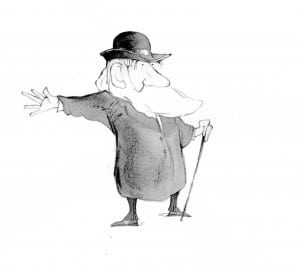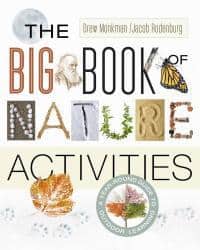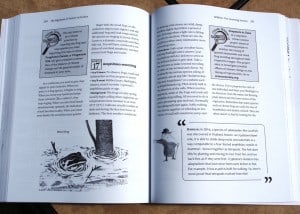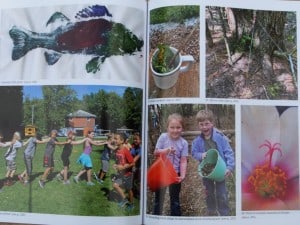The average North American child can identify over 300 corporate logos, but only 10 native plants or animals – a telling indictment of our modern disconnection from the natural world. Even though children are born with an innate interest in nature, our society does little to nurture this predisposition. It is largely for this reason that Jacob Rodenburg, Executive Director of Camp Kawartha, and I decided four years ago to sit down and write a book to help address this problem.
Released just last week by New Society Publishers, “The Big Book of Nature Activities: A year-round guide to outdoor learning” sets out to answer the question “What can you do outside in nature?” In response, the book provides nearly 150 activities, including games, crafts, drama, and stories. It will also help young and old alike to become more aware of how the sights, sounds, smells, textures and tastes of the natural world change from one season to the next. The book is aimed at parents, grandparents, classroom teachers, outdoor educators and youth leaders of all kinds. Much of the information – and many of the activities – will also be of interest to adults, especially if you need to brush up on your own nature skills. Adults should also be interested in the extensive background information on evolution, citizen science projects, nature journaling, nature photography and how to make the most of digital technology,
Introduction
We begin the book by discussing the disconnection from nature that characterizes so much of modern society. In an increasingly urbanized world, our children are much more likely to experience the flickering a computer screen or the sounds of traffic than the rhythmic chorus of bird or insect song. And sadly, they can more easily identify corporate logos or cartoon characters than even a few tree or bird species. We therefore ask the questions: Where will tomorrow’s environmentalists and conservationists come from? Who will advocate for threatened habitats and endangered species? What are the impacts on one’s physical and emotional well-being from a childhood or adulthood spent mostly indoors? We then go on to discuss some of the consequences of what the environmental educator Richard Louv calls “Nature Deficit Disorder”.
The activities, species and events in nature, which are described in the book, cover an area extending from British Columbia and northern California in the west to the Atlantic Provinces and North Carolina in the east. This includes six ecological regions such as the Marine West Coast and the Eastern Temperate Forests. In other words, the book applies to most anywhere in North America where there are four seasons.
The introduction also provides ideas on how to raise a naturalist (hint: take your kids camping!), how to get kids outside, how children of different ages respond to nature, how nature can enhance our lives as adults and the importance of being able to identify and name the most common species. We provide lists of 100 continent-wide key species to learn – everything from birds and invertebrates to trees, shrubs and wildflowers – as well as about 50 key regional species. We also introduce the reader to three cartoon characters, namely Charles Darwin, Carl Sagan and Neil DeGrasse Tyson who will tell stories of the wonder of evolution and the universe throughout the book.

Our Charles Darwin cartoon character gives examples of the wonder of evolution throughout the book – Kady MacDonald Denton
Basic Skills
Connecting to nature is easier when you have learned some basic skills. In this section, we provide hints for paying attention (be patient and slow down), how to engage all the senses (learn to maximize your sense of smell), how to lead a nature hike (have some “back-pocket” activities ready to go), nature-viewing and traveling games from a car or school bus (do a scavenger hunt), how to increase your chances of seeing wildlife (try sitting in one place), how to bring nature inside (set up a nature table), how to get involved in “citizen science” (start at scistarter.com) and how to connect with nature in the digital age (make the most of your smartphone and social media). The latter section is especially detailed. Although it might seem counter-intuitive, there are actually many ways in which digital technology can inspire people of all ages to explore nature and share their experiences with others.
We also provide information on the basics of birding; insect-watching (butterflies, dragonflies, damselflies and moths), plant identification, mushroom-hunting, getting to know the night sky, nature journaling, nature photography, and nature-based geo-caching. Additional basic skills are covered in the activities in the seasons chapters themselves. These include fish-watching, mammal-watching, amphibian- and reptile-watching and tree identification.
Key Concepts
The third chapter in “The Big Book of Nature Activities” deals with four important concepts, which help us to more fully understand and appreciate nature. We start by explaining why we have seasons, and how the tilt of Earth’s axis makes all the difference. This is followed by a discussion of phenology, which is the science of observing and recording “first events”- such as spring’s first lilac bloom or frog song. Next, we talk about how climate change is affecting different habitats and species, and why a connection with nature is so important in light of this threat. Finally, we discuss the importance of understanding evolution and how it is manifested in even the most common backyard species. Armed with a little knowledge of evolution, we can learn to appreciate the wonder that resides in all species, not just the charismatic ones. We also want children to know that science is just beginning to unravel many of the mysteries of evolution and the incredible stories it has revealed. Our Darwin cartoon character tells many of these stories. The good news for young scientists-to-be is that there’s so much we don’t yet understand
The book explains the basics of evolution and natural selection, without getting into the details of genetics. We then provide a story for young children on how evolution might work within a population of imaginary sand bugs. For older children and adults, we go on a “field trip of the imagination” in which we visit our ancestors, starting with our self, our grandfather, our great-grandfather, etc. and ending up at our 185-million-greats-grandfather who, by the way, would have been a fish! This section concludes with a shortened version of Big History, the evidence-based story that takes us from the Big Bang to the present, in which we humans are “star stuff pondering stars”.
Seasons’ chapters
The four seasons’ chapters make up the heart of the book. Each begins with a summary of some of the key events in flora, fauna, weather and the sky. This includes events that occur across North America as well as happenings that are specific to each region. Most of the activities in the chapter relate to these events. This is followed by a seasonal poem to enjoy and maybe memorize; suggestions for what to display or collect for the nature table;
ideas about what to photograph or record in your nature journal; a short seasonal story called “What’s Wrong with the Scenario” in which you try to spot the mistakes; the story of Black Cap, the Chickadee, which takes you through a year in an individual chickadee’s life and includes activities; and ideas for what to do at your Magic Spot, a special nature-rich area close to home.
The final and largest section of the seasons’ chapters is called “Exploring the season: Things to do.” It comprises 50 or more activities to activate your five senses, keep track of seasonal change, explore evolution, and have fun discovering fascinating aspects of birds, mammals, reptiles, amphibians, fish, invertebrates, plants, fungi, weather and the night sky. We also offer up suggestions on how to make nature part of seasonal celebrations like Thanksgiving. Some of the activities include making a scent cocktail and touch bag, using a roll of toilet paper to create a history-of-life timeline, meeting the “beast” within you, a non-identification bird walk, a woodpecker drumming game, mammal-watching with a trail camera, observing spawning salmon, a frog song orchestra, exploring seaside beaches and tide pools, a “bee dance” drama game, conducting a pond study, “adopting” a tree to observe over an entire year, dissecting flowers, a fungi scavenger hunt, a classroom “hand-generated” thunderstorm, going on a night hike, making tin can constellations, creating your own moon phases, celebrating the winter and summer solstices, ideas for Earth Day, and more. Scattered throughout the activities are suggestions for getting involved in citizen science projects. The book concludes with an appendix with blackline masters for photocopying and a detailed index.
The book also contains several hundred drawings, most of which were done by talented Lakefield artist, Judy Hyland. Others were contributed by Kim Caldwell, Kady MacDonald Denton, Jean-Paul Efford and Heather Sadler (drawings by her late father, Doug Sadler). In the middle of the book, you will find a 16-page block of colour photos by the authors and others.
“The Big Book of Nature Activities” is available at Happenstance Books and Yarns at 44 Queen Street in Lakefield (705-652-7535), at Camp Kawartha (1010 Birchview Road, Douro-Dummer), at Chapters (Landsowne Street west in Peterborough) and online at Chapters.Indigo.ca and Amazon.ca. It would make a great end of school year gift. The cost is $39.95. A book launch hosted by Happenstance will be held on July 24, from 2-4 p.m. at the Camp Kawartha Environment Centre at 2505 Pioneer Road. For more details and regular updates about the book, please go to drewmonkman.com. The authors can be reached by email at dmonkman1@cogeco.ca and jrodenburg@campkawartha.ca


